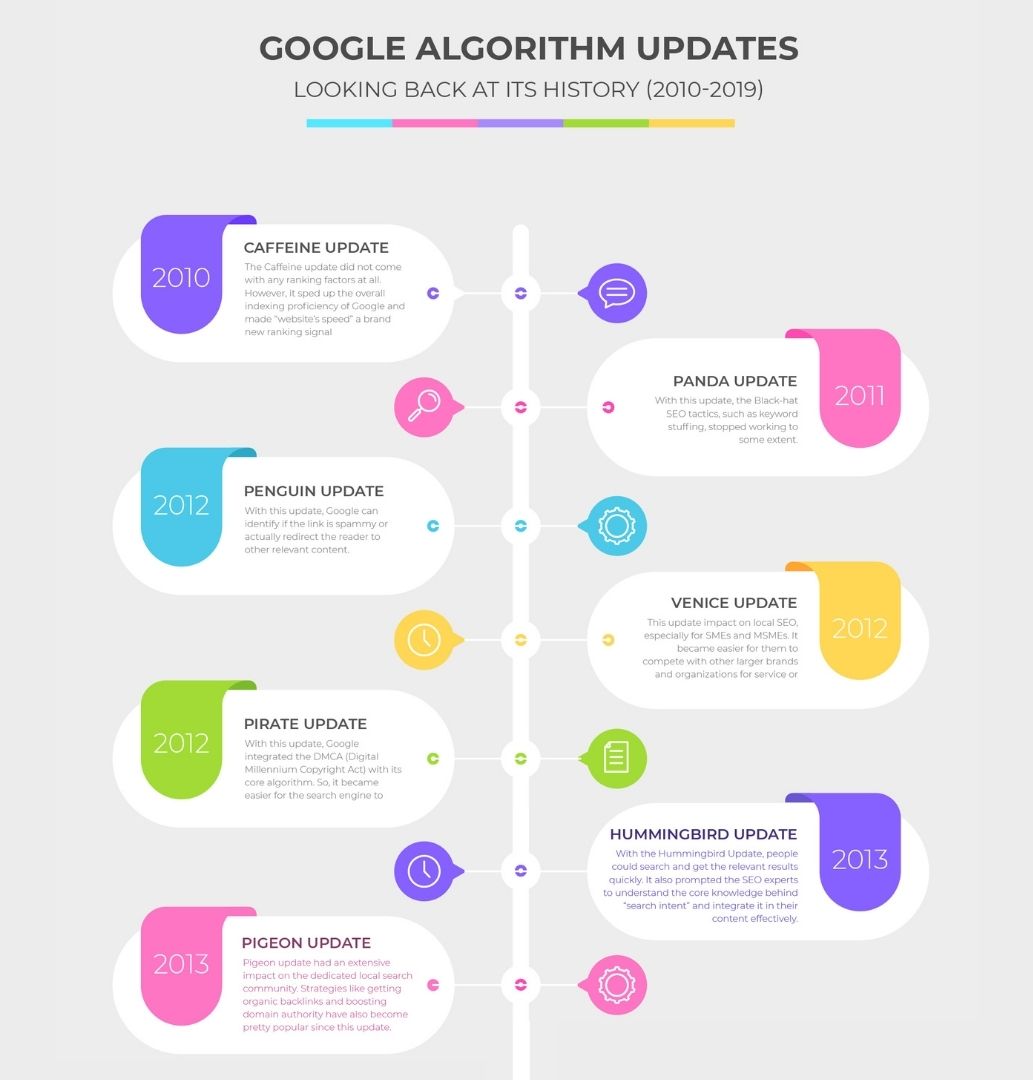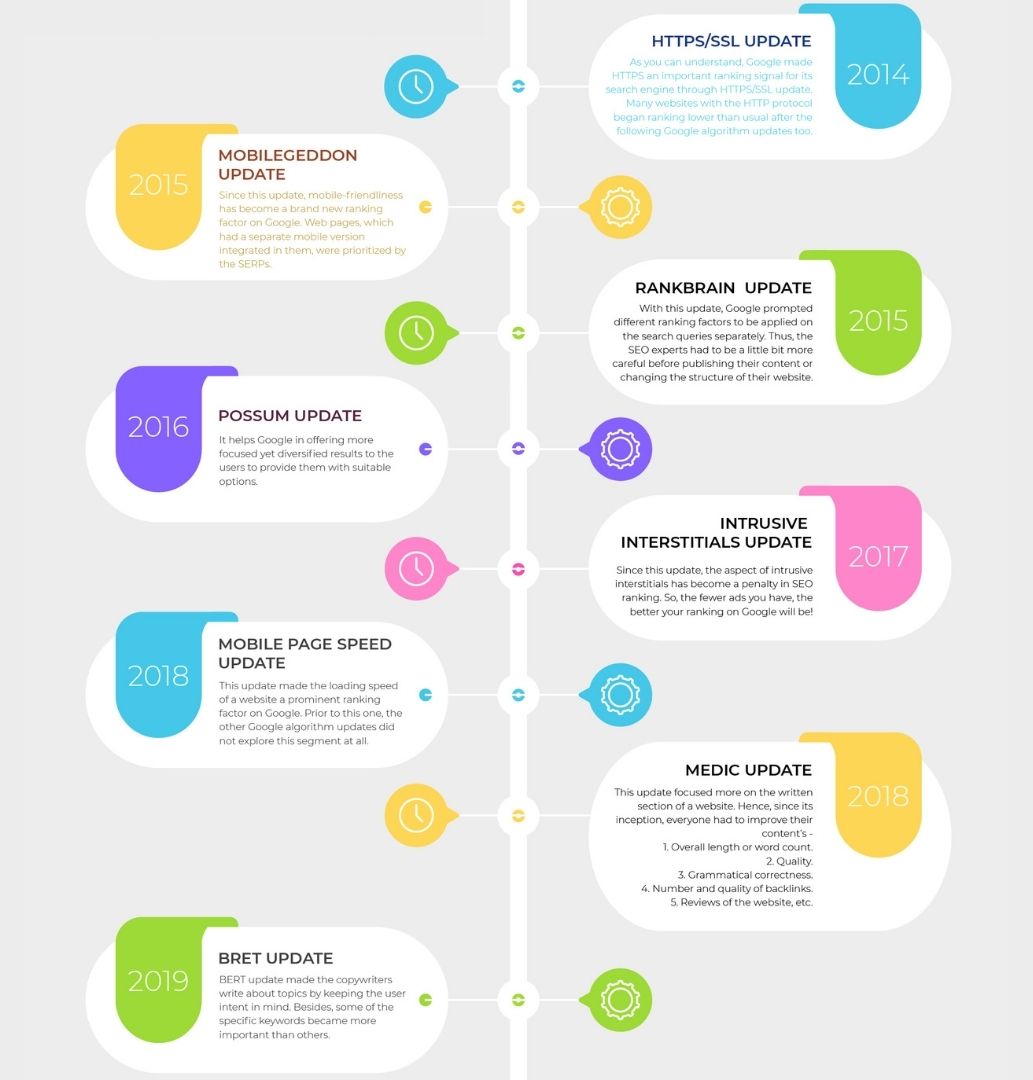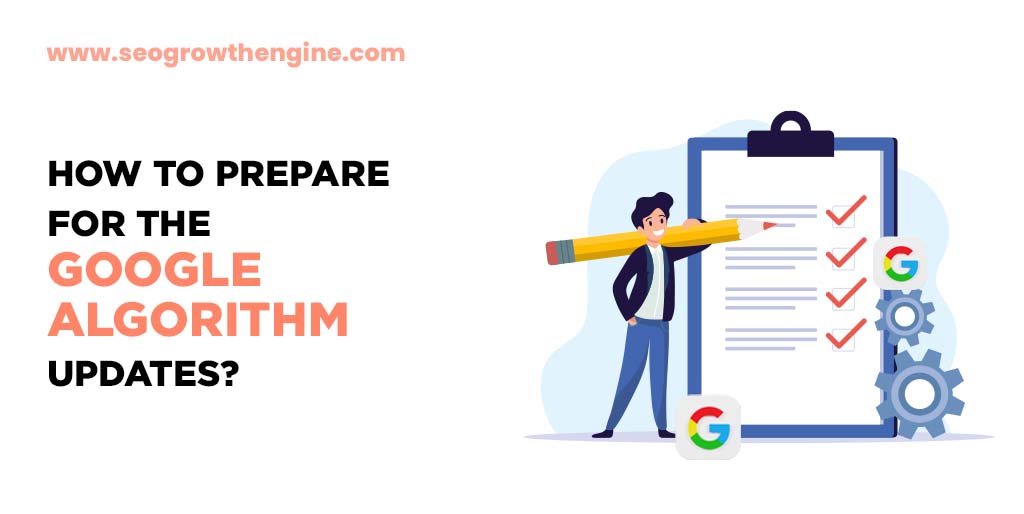Whether you believe it or not, the Google algorithm updates usually arrive pretty frequently. According to a report, the tech conglomerate refurbishes its algorithm almost 500-600 times a year. That means the whole system gets upgraded at least once or twice a day!
However, fortunately, most of these updates are pretty minor and, therefore, don’t affect the search engine all too much. And, if Google considers making a huge change, it offers insights on it beforehand to help everyone get prepared.
In any case, if you are a webmaster, you should definitely know about the broad history of Google algorithm updates. This way, it will be easier for you to set up your site efficiently and improve it better. Hopefully, we can help you out in this regard through our article!
Google Algorithm Updates – A Brief Overview
Google algorithm, in essence, is a complex system that helps in answering people’s search queries optimally. And for that, it uses more than 200 different ranking factors.
These rules help the search engine to find relevant data from its index and discover the webpage that has offered the best answer.
So, for example, if you have provided every possible information regarding a search query, Google will rank your website first on its SERP. The least-preferable websites will be kept hierarchically later on.
While it’s the general idea of a SERP ranking, the Google updates 2021 have changed this notion to some extent. You will find more on it later in this article.
Anyway, before we move on, let us tell you a secret.
The core Google algorithm updates are usually the ones that inflict a significant change on how the search engine works. Hence, in a way, it will affect how your website performs. Moreover, the overall user experience of your site will take a hit as well.
So, we will ask you to keep an eye on such news to prepare yourself as early as possible!
Google Algorithm Updates – Looking Back At Its History (2010-2019)

Since the first core update in 2010, Google has changed its search engine algorithm quite consistently. Each of them has brought something new to the table while discontinuing irrelevant practices altogether.
In this section, we will talk about the SERP overhauls that came around during the 10-year tenure of 2010-2019. However, before we begin, here are the names of each of these Google algorithm updates that you should know about!
- Caffeine – 2010 update
- Panda – 2011 update
- Penguin – 2012 update
- Venice – 2012 update
- Pirate – 2012 update
- Hummingbird – 2013 update
- Pigeon – 2013 update
- HTTPS/SSL – 2014 update
- Mobilegeddon – 2015 update
- RankBrain – 2015 update
- Possum – 2016 update
- Intrusive Interstitials Update – 2017 update
- Mobile Page Speed Update – 2018 update
- Medic – 2018 update
- BERT – 2019 update
Now that you know the names of the Google Updates let us make you a little familiar with them.

Caffeine Index Update – 2010
Launched in 2010, the Caffeine Index Update of Google was all about speeding up the search results for users. Besides, it also helped the web admins and publishers to get their content or blogs seen faster than usual.
That’s not all!
The Caffeine update also made it easier for the Google bots to crawl faster and store data much more effectively. This way, the search engine could offer newer results 50% quicker.
All in all, the update was made to meet the rapidly-growing web demand and Google was successful in it.
How Did It Impact SEO?
The Caffeine update did not come with any ranking factors at all. However, it sped up the overall indexing proficiency of Google and made “website’s speed” a brand new ranking signal.
Panda Update – 2011
Contrary to Caffeine, the Panda Update did introduce a brand new ranking factor in Google’s search engine. It helped Google to penalize websites for keyword stuffing and content farming to offer a better experience to the users.
It, in turn, helped the search engine in identifying low-quality and spammy content and removing it from the top-ranking page.
How Did It Impact SEO?
With this update, the Black-hat SEO tactics, such as keyword stuffing, stopped working to some extent. Moreover, the digital markting experts also had to check if their content was providing any value to the reader or not. Otherwise, it would not rank higher on Google.
Suggested: Difference Between Black-Hat SEO And White-Hat SEO? Which One Do You Prefer?
Penguin Update – 2012
Since Google shut off keyword stuffing in 2011, many people began using manipulative link-building strategies and webspam to rank higher. Thus, the search engine came up with three different Google algorithm updates to counter this issue.
And, the Penguin Update was the most important one amongst them!
Thanks to its implementation, Google can identify if the link is spammy or is redirecting the reader to other relevant content. Due to the nature of the change, Google also called Penguin the “webspam algorithm update.”
How Did It Impact SEO?
With the Penguin Update rolling out, spammy websites and low-quality backlinks began disappearing from the face of the internet. Besides, organic ranking and traffic became much more important than the previous instance on Google.
Venice Update – 2012
Unlike Penguin, the Venice Update focused more on the search results regarding services and products. For example, it helped people find a store or business quickly with regards to their geographical proximity.
Think of queries like “restaurants near me” or “the best restaurant in New York.” These search queries became more prominent after the Venice Update in 2012.
How Did It Impact SEO?
Unlike most other Google algorithm updates, this one made an explosive impact on local SEO, especially for SMEs and MSMEs. It became easier for them to compete with other more prominent brands and organizations for service or product-related key phrases with a local intent!
Pirate Update – 2012
During the 2010s, Copyright infringement became a significant issue on search engines, especially on Google. Thus, Google decided to take care of this nuisance by rolling out the Pirate Update in 2012.
And, it did exactly what its name indirectly implied – stopped piracy.
In this update, Google integrated the DMCA (Digital Millennium Copyright Act) with its core algorithm. So, it became more accessible for the search engine to catch anomalies whenever someone violated the rights firsthand.
How Did It Impact SEO?
If your website was violating the DMCA act and Google could verify it, the site would be heavily penalized. It will not rank any higher as usual too!
Hummingbird Update – 2013
The Hummingbird Update focused more on the search engine experience and affected it massively. For example, it helped Google in understanding the true meaning of “search intent.”
Thus, the search engines could contextualize user queries efficiently and offer the correct results in a jiffy!
How Did It Impact SEO?
With the Hummingbird Update, people could search and get the relevant results quickly. It also prompted the SEO experts to understand the core knowledge behind “search intent” and integrate it into their content effectively.
Pigeon Update – 2013
The Pigeon Update was all about improving the local search results on Google. It took the instances of the geometrical location of the user while answering queries and improved it even more. Thus, it became even easier for people to find stores in their neighborhoods without wasting time.
How Did It Impact SEO?
Needless to say, the pigeon update had an extensive impact on the dedicated local search community. It strengthened the small businesses that implemented the fundamental SEO practices as well. Strategies like getting organic backlinks and, boosting domain authority, have also become pretty popular since this update.

HTTPS/SSL Update – 2014
The HTTPS/SSL Update, in essence, was a part of the “HTTPS Everywhere” campaign. The intention behind the same was to make the website and the internet more secure to offer a safe searching experience.
In short, Google encouraged webmasters to get the SSL update and transfer their sites to HTTPS from HTTP.
How Did It Impact SEO?
As you can understand, Google made HTTPS a critical ranking signal for its search engine through HTTPS/SSL update. Many websites with the HTTP protocol began ranking lower than usual after the following Google algorithm updates too.
Mobilegeddon Update – 2015
The usage of mobile phones for searching on Google has increased massively since 2013. Hence, Google came up with the Mobilegeddon update to accommodate the smartphone users for its search engine in April 2015.
Otherwise known as the “mobile-friendly update,” Mobilegeddon made the visual aspects of a website its focal point. For instance, the images and fonts of a site needed to be optimized to make everything look clearer on smaller screens.
How Did It Impact SEO?
Since this update, mobile-friendliness has become a brand new ranking factor on Google. Web pages, which had a separate mobile version integrated into them, were prioritized by the SERPs. However, at this point, the aforesaid example applied to a single webpage, not the complete website.
RankBrain Update – 2015
The RankBrain update introduced a brand new AI system in the Google algorithm to determine relevant results of a query. Hence, at its core, it was much different and had a more extensive impact on SEO than the Google algorithm updates.
But, how did the search queries work following this update?
With this update, whatever you searched on Google went through an interpretation model, which combined factors like word count and location. It helped Google in determining the search intent of the user and delivering relevant results.
How Did It Impact SEO?
With this update, Google prompted different ranking factors to be applied on the search queries separately. Thus, the SEO experts had to be a little bit more careful before publishing their content or changing the structure of their website.
Possum Update – 2016
Like a few other previous Google algorithm updates, the Possum Update also attempted to improve local search intent even more. Before Possum, businesses that were located outside of the city limits struggled to rank higher on Google.
However, the new update fixed these severe issues effectively. Besides, it also boosted the overall importance of a searcher to optimize the usage of local terms efficiently.
How Did It Impact SEO?
When it comes to effectiveness, the Possum Update holds the highest bet of importance. It helps Google in offering more focused yet diversified results to the users to provide them with suitable options.
Intrusive Interstitials Update – 2017
In the first part of 2017, Google rolled out a new update to cut down on intrusive interstitials. These are, in essence, large pop-ups that cover a considerable section of a webpage. This, in turn, makes it difficult for the user to read the content appropriately.
According to Google, the search engine wanted to focus more on user experience. Hence, it tried to remove the spammy websites from the SERPs as much as possible through this update.
How Did It Impact SEO?
Since this update, the aspect of intrusive interstitials has become a penalty in SEO ranking. So, the fewer ads you have, the better your ranking on Google will be!
Also Read: Google Search Ranking & Algorithm Shifts Still Underway
Mobile Page Speed Update – 2018
In 2018, Google began caricaturing with its search engine module even more. As a result, we were bombarded with two new initiatives, “mobile-first” and “speed up the internet.” And, the Mobile Page Speed Update was prompted solely due to the latter! Google confirmed via Twitter the release of another broad core algorithm update,
Since this update, it has become a must for SEO experts to take care of the technical SEO of their website. If your website opens within three to five seconds after clicking, it will rank much higher than the slower sites.
How Did It Impact SEO?
This update made the loading speed of a website a prominent ranking factor on Google. Prior to this one, the other Google algorithm updates did not explore this segment at all. Hence, it caused quite havoc amongst the SEO experts and affected their SEO strategies!
Medic Update – 2018
Considering the other Google algorithm updates, Medic was relatively minor and focused on a single segment. It helped in integrating the EAT principle in online content marketing (authority, expertise, and trustworthiness).
How Did It Impact SEO?
This update focused more on the written section of a website. Hence, since its inception, everyone had to improve their content’s –
- Overall length or word count.
- Quality.
- Grammatical correctness.
- Number and quality of backlinks.
- Reviews of the website, etc.
BERT Update – 2019
The BERT (Bidirectional Encoder Representations from Transformers) algorithm is essentially a language of Google’s machine learning system. It helps the search engine understand what a specific word means in the context of a sentence.
In short, the BERT Update made it easier for search engines to perceive search queries more efficiently and effectively. Besides, it could also determine the quality of a web page or content quicker than before.
But, how does BERT work?
Wait, let us give you an example.
Let’s say you are saying, “Lionel Messi is the GOAT.” This doesn’t necessarily mean that you are comparing him to a farm animal. Instead, you are implying that “Lionel Messi is the Greatest Of All Time.”
With the BERT Update, Google can make this distinction efficiently now!
How Did It Impact SEO?
Opposing other Google algorithm updates, the BERT integration was entirely unique. It made the copywriters write about topics by keeping the user intent in mind. Besides, some of the specific keywords became more important than others.
If you are offering correct information and writing quality content, Google can also understand jargon easily!
Also Read: Top 7 Reasons Why Your Business Needs A Chatbots
Google Algorithm Updates – The New Additions
Hopefully, now you have an idea regarding how Google’s algorithm has changed over the years. Now, let us guide you through the latest ones and explain a little about them.
The latest Google Algorithm updates list, here we go!
Google Algorithm Update 2020
Google rolled out three major algorithm updates in the year 2020. Each of them was pretty distinctive and helped the search engine cover different loopholes in their system. Here’s some extensive information regarding Google algorithm updates that you should know about!
Google Algorithm Update January 2020
Launched on January 13th, this core update was all about featured snippets. During the rollout of this change, Danny Sullivan from Google confirmed that if your webpage is in a featured snippet position, it won’t be kept in the organic listing anymore.
It affected the ranking of a website to some extent. Many people also tried to get rid of their “featured snippet” position to improve their organic ranking.
Google Algorithm Update May 2020
The May update focused more on improving the EAT segment of SEO. After the upgrade rolled out, many content writers saw issues regarding backlinks dropping to some extent. Besides, the emphasis on quality content increased even more following this update.
Since this update, Google now takes the reviews available on your website into account before ranking it on SERPs. So, for example, if you have negative comments throughout your web pages, it will not rank higher anymore.
Google Algorithm Update December 2020
The December 2020 update offered a few changes and tweaks on various ranking factors. For example, in this core update, Google increased the value of using focus keywords on the H1 tag by 2%. Conversely, the importance of HTTPS on a website increased by 18%.
However, the value of keeping the keyphrase in a title tag decreased by 9% following the update. Some changes in the generated content segment were also evident in this regard.
Google Algorithm Update 2021
Unlike the previous year, Google made five core changes in its algorithm in 2021. Here is what you need to know in this regard.
Google Algorithm Update February 2021 – Passage Ranking
Considered as one of the most important Google algorithm updates in 2021, Passage Ranking made it possible for the search engine to rank particular passages. This way, it became easier for Google to satisfy specific search intent from users.
Since this update, Google can bring out particular passages from your content and rank it on the SERPs. Hence, it, in turn, made certain forms or parts of on-page SEO much more valuable. For instance, now long-tail keywords carry a lot more importance than they used to.
Google Algorithm Update April 2021 – Product Reviews
There was a time when it was easy for thinner and less-oriented reviews to rank higher on Google. However, the Product Review update changed things entirely in this regard.
Now, you have to take a product and write every detail of it as exploratively as possible. Your intent would be to provide the right information to the user so that they can make a buying decision quickly.
However, there’s one aspect that you need to remember in this regard.
Google will not directly penalize a website with sub-optimal product reviews. However, if your writing quality is better than theirs (including structure, information, etc.), your website will rank much higher.
Google Algorithm Update June 2021
The June core algorithm update denoted the improvement of loading experience to some extent. The vitals of this change depended on three different metrics –
- FID or First Input Delay
- LCP or Largest Contentful Paint
- CLS or Cumulative Layout Shift
This update was a part of the “speed up the internet” initiative of Google. Therefore, if your website was otherwise quick and well-optimized, you could benefit a lot from these changes.
Google Algorithm Update July 2021
By rolling out the July Algorithm update, Google attempted to improve the importance of quality links on a website. Hence, the websites with more backlinks and higher authority saw a rise in their ranking on the search engine.
Google Algorithm Update November 2021
The final one amongst the Google updates 2021 tried to improve the issues regarding keyword and link spamming. However, Google did not reveal too much regarding the November 2021 update. And, we haven’t seen any considerable changes in terms of SERP ranking too!
How To Prepare For The Google Algorithm Updates?

Broadly speaking, it’s almost impossible for anyone to prepare their website perfectly for a Google algorithm update. And, rightly so, too!
Google changes its search engine-based algorithm around 500-600 times every year. Therefore, it becomes almost impossible for anyone to keep track of what’s happening.
Hence, instead of worrying too much, we would ask you to follow the guidelines provided by Google. Aside from that, you can also follow the below-mentioned tips to keep your website well-optimized and prepared for the Google algorithm updates!
- Write quality content.
- Integrate keywords naturally and efficiently.
- Use more long-tail keywords.
- Increase the loading speed of the web pages.
- Include FAQs after writing a blog.
- Use correct data and statistics on your content.
- Boost the website UI and overall performance to some extent.
- Make sure that your website is stable and has an optimal working condition.
Frequently Asked Questions(FAQs)
Google Algorithm Updates – Final Thoughts
Google is pretty sincere and persistent when it comes to updating its search engine algorithm. Thus, if you want your website to rank higher on Google, you will need to focus more on your site’s performance.
Besides, the Google algorithm updates sometimes also focus on content quality. So, we would suggest working on that segment as well. In our opinion, making these two aspects your focal point should make it easier to tackle the changes efficiently.
Anyway, we will finish our article on Google algorithm updates here. Hopefully, we could help you increase your knowledge on this subject. Nonetheless, if you still have any queries, make sure to let us know in the comments below. We’d love to answer them!
Read Also:








